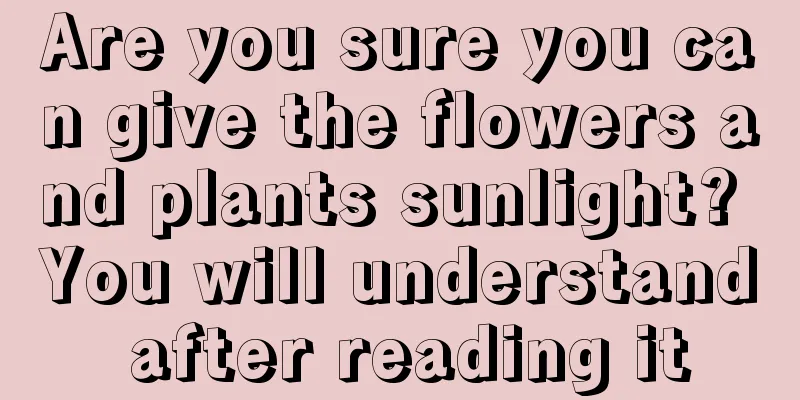Are you sure you can give the flowers and plants sunlight? You will understand after reading it

Long-term exposure to the sunSome flower lovers simply throw their flowers and plants outside and leave them there, especially in the hot summer, without even any shade. This behavior is highly undesirable. Of course, plants that particularly like sunlight, such as jasmine and gardenia, can still tolerate it. Symptoms that may occur: Yellowing, blackening, or reddening of leaf tips Although plants like light, it does not mean that they like all light. Too strong light will inevitably cause damage to plants! The leaves of plants are the most obvious sign of sunburn! Solution:Sunburned leaves cannot recover, so move the sunburned plants to a cool place, or place the plants directly indoors away from sunlight. will already Remove the sunburned leaves, maintain them normally, and wait for the plant to grow new leaves . (Author: Tianjian Mi Tuan Source: Succulent Plant Bar) (Author: Quiet Heavenly Palace Source: Green Radish World Bar) As shown in the last picture, almost all the leaves are sunburned, so we can only put it in a cool place and wait for it to slowly grow new leaves and replace the old leaves. (Author: candy2 by the ear Source: Succulent Plants Bar) Long-term shadingPlants cannot grow without sunlight. Only under light can they carry out photosynthesis and produce the nutrients needed for plant growth. Long-term shading will inevitably inhibit plant growth. Common symptoms: elongation Flower lovers who have grown succulents should all know this phenomenon, right? This phenomenon is not unique to succulents. Any plant that does not receive sufficient sunlight for a long time will easily grow thin and tall, and look like it is about to break! For example, the daffodils in the picture below have thin and long leaves, which are easy to fall over when they grow up. If they are not dealt with, the second picture will be the final result... Solution:1. Get more sun exposure. This is the most convenient way to solve the problem of excessive growth. 2. Topping. If your plant has grown very tall, just topping it. Topping can suppress the apical dominance of the plant and promote branching! Look at the picture below! (Author: Chu Shi Source: Zhihu) (Source: Baidu Knows) Long-term non-rotationPlants have phototropism. What does phototropism mean? It means that plants will unconsciously spread to places where they can be exposed to sunlight. For example, the plant in the picture below is bent 90°, which is caused by phototropism! Common symptoms: The plant becomes crooked Nowadays, most flower lovers probably place their plants on balconies, windows, or bay windows, right? In these locations, due to the obstruction of the house, some parts of the plant will inevitably not be able to get sunlight, and the part that can get sunlight will continue to extend to the place where the sun can get sunlight. Finally, what appears in front of you is a crooked Kalanchoe... For example, the Kalanchoe in the picture below Solution:Rotate the pot of the Kalanchoe once a week or so so that it can get sunlight evenly. (Author: bjayul Source: Kalanchoe Bar) (Author: Chen Meihuan Source: Luohu Education Network Blog) Sunbathing through the glassGlass can block most of the ultraviolet rays in the light, and ultraviolet rays are one of the important factors that inhibit the growth of plants. Therefore, sunbathing through glass may also cause leggy growth. Common symptoms: elongation It's not so bad in winter because the temperature is relatively low and the growth of plants is small, so there is no impact from the glass. However, in spring and summer, which are the growing seasons for plants, the plants grow rapidly and cannot receive ultraviolet rays through the glass. The plants will grow thin and long, especially the sun-loving plants. Solution:In spring, summer, autumn and other seasons, it is best not to expose the flowers to the sun through the glass. Move the flowers and plants outside, or open the balcony windows to receive a few hours of pure sunlight every day. Note: shade is required in summer! |
<<: Are you buying and caring for New Year flowers correctly?
>>: How to propagate the bright grass
Recommend
Cultivation methods and precautions of Molan
1. Soil It is recommended to use loose, fertile, ...
How often should fertilize the red flower
1. How many days should you apply fertilizer? 1. ...
Where does Shaanxi thuja grow?
Where does Shaanxi thuja grow? Shaanxi Thuja gene...
How long does it take for potatoes to sprout and emerge from the soil? The 5 stages and steps of potato planting
How long does it take for potatoes to sprout? The...
What is the best fertilizer for Strelitzia reginae?
Summer is the season when Strelitzia has a greate...
How to keep elm bonsai in winter
temperature When it comes to winter, severe cold ...
What month is suitable for planting honeysuckle?
When to plant honeysuckle Honeysuckle is generall...
Cultivation methods and precautions of cat's whiskers
1. Nutrient management It is essential to provide...
Is windmill jasmine poisonous?
1. Is it toxic? It is toxic. Because it is a plan...
He never adds fertilizer, he just throws some of this into the pot and the flowers bloom like crazy!
1 shrimp head When eating shrimps, Huahua usually...
The best time to take hibiscus cuttings
1. Best time for cuttings The best time for hibis...
How to top the fiddle-leaf fig and when to prune it
1. How to pinch the top of fiddle-leaf fig 1. Tim...
What areas are suitable for growing golden pears?
Golden pear planting conditions 1. Light: Golden ...
The efficacy and function of pearl bush
Medicinal effects Pearl bush is rich in fragrance...
How to propagate Gloxinia and what to pay attention to
How to propagate Gloxinia The main ways of propag...









